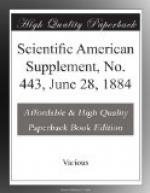To avoid this, the quantity of alkali required to saponify the myricine is first ascertained, and then that required to saturate the free cerotic acid. In this way two numbers are obtained; and in an investigation of twenty samples of Austrian yellow beeswax, the author found these numbers stood to each other almost in the constant ratio of 1 to 3.70. Although this ratio cannot be considered as definitely established by so few experiments, it may serve as a guide in judging of the purity of beeswax.
The experiment is carried out as follows: 3 or 4 grammes of the wax that has been melted in water are put in 20 c.c. of neutral 95 per cent, alcohol, and warmed until the wax melts, when phenolphthaleine is added, and enough of an alcoholic solution of potash run in from a burette until on shaking it retains a faint but permanent red color. The burette used by the author is divided in 0.05 c.c. After adding 20 c.c. more of a half normal potash solution, it is heated on a water bath for 3/4 hour. Then the uncombined excess of alkali is titrated with half normal hydrochloric acid. The alcohol must be tested as to its reaction before using it, and carefully neutralized with the acid of phenolphthalein.
To saturate the free acid in 1 gramme of wax requires 19 to 21 milligrammes of potassic hydrate, while 73 to 76 milligrammes more are necessary to saponify the myricine ether. The lower numbers in the one usually occur with low numbers for the other, so that the proportions remain 1 to 3.6 or 1 to 3.8.
For comparison he gives the following numbers obtained with one gramme of the more common adulterants:
----------------+----------+----------+---------+------
--+ | To | To | Total | | |neutralize| convert |saponifi-| | | the acid.|the ether.| cation. | Ratio. | ----------------+----------+----------+---------+--------+ Japanese wax | 20 | 200 | 220 | 10 | Carnauba wax | 4 | 75 | 79 | 19 | Tallow | 4 | 176 | 180 | 44 | Stearic acid | 195 | 0 | 195 | 0/195 | Rosin | 110 | 1.6 | 112 | 0.015 | Paraffine | 0 | 0 | 0 | 0 | Ceresine | 0 | 0 | 0 | 0 | Yellow beeswax | 20 | 75 | 95 | 3.75 | ----------------+----------+----------+---------+--------+ pre>The author deduces the following conclusions as the results of these investigations:
1. If the numbers obtained lie between these limits, 19 to 21, 73 to 76, 92 to 97, and 3.6 to 3.8 respectively, it may be assumed that the beeswax is pure, provided it also corresponds to beeswax in its physical properties.
2. If the saponification figures fall below 92 and yet the ratio is correct, it is adulterated with some neutral substance like paraffine.
3. If the ratio is above 3.8, it is very probable that Japanese or carnauba wax or grease has been added.




